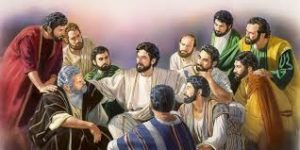The Private Parables of the Kingdom in the House
From the very day of His official rejection by the Pharisees and the nation of Isra’el, Jesus spoke in parables to the masses. Those of faith would understand the parables and those of no faith would not. Yeshua finished His parables by the Sea of Galilee (to see link click Es – The Public Parables of the Kingdom by the Sea), and went into the house of Simon Peter who lived in Capernaum. At some point His family showed up because they were concerned about Him (see Ey – Jesus’ Mother and Brothers). In the evening, when He was finally alone with His own talmidim, He explained everything (Mark 4:34). For the masses the purpose was to hide the truth, for the faithful, the purpose was to illustrate the truth.711
If the Twelve had faith, why did they need the parables explained to them? This is what the gift of teaching is all about. If the things of God didn’t have to be taught or explained, there would be no need for the gift of teaching. This is the difference. For the faithful, once it was explained, they understood it and believed it (see Ft – The Faith of a Canaanite Woman). But, for the faithless, even after it was taught, they wouldn’t understand it, or even if it were possible for them to understand, they wouldn’t have believed it.

After He had left the most of the large crowd down by the seashore and entered the house of Peter. Later that evening after sundown, His apostles would ask Him about this parable (Mark 7:17). They were faithful men who needed to be taught. Is it no less true for us today? That is why the gift of teaching is needed in the congregations of God.
After the introductory parable of the Soils, there are four other couplets of parables. The first set of couplets were given by the Sea of Galilee to the Twelve and the large crowd made up of believers and unbelievers, and the second set of couplets are given to the apostles in the house of Peter in Capernaum. The third couplet is comprised of the parables of the Hidden Treasure (Isra’el) and the Pearl of Great Price (Gentiles), which show the dividing wall of hostility has been broken down (Ephesians 2:14-18) and Jews and Gentiles together form the invisible universal Church. The fourth couplet is made up of the parables of the Dragnet (saved and lost) and the Householder (old and new), where we see some comparisons between life now and life in the future the messianic Kingdom.



Leave A Comment